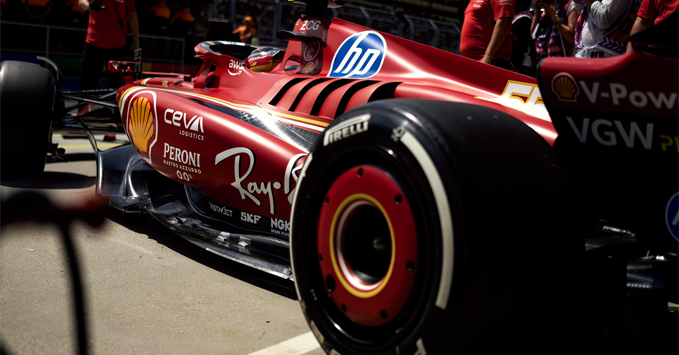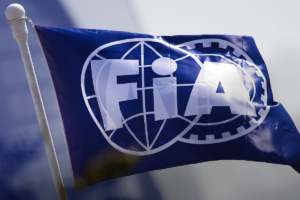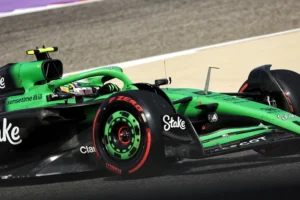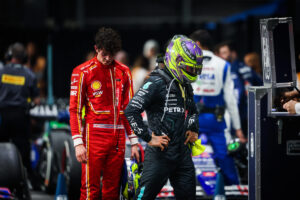Breaking news:First Details of Lewis Hamilton & Charles Leclerc groundbreaking new Ferrari F1 car unveiled…read more

First Details of Lewis Hamilton & Charles Leclerc groundbreaking new Ferrari F1 car unveiled…read more
The first details of Ferrari’s groundbreaking Formula 1 car for 2025, which will be driven by Lewis Hamilton and Charles Leclerc, have recently been revealed. This new car marks a significant departure from the SF-24 used in the 2024 season. One of the most notable changes is the switch from a push-rod suspension system to a pull-rod suspension at the front. This change requires a complete redesign of the front chassis to accommodate the new setup. Although the rear suspension will continue using the pull-rod configuration, Ferrari plans to refine the kinematics and introduce a shortened gearbox to enhance overall performance.
In addition to the suspension changes, Ferrari is also redesigning the sidepod air inlets. These will be repositioned and reduced in size to better manage the air turbulence generated by the front wheels, a key aerodynamic challenge. Ferrari hopes these changes will improve the car’s overall aerodynamics and help it perform more effectively on the track.
Looking back at Ferrari’s 2024 season, the team made considerable progress, finishing second in the Constructors’ Championship behind McLaren. While the SF-24 maintained a visual resemblance to its predecessor, the SF-23, it featured significant internal changes. Notably, the fuel tank area was lengthened, and the gearbox was shortened by approximately 5 cm, while maintaining the same wheelbase. These modifications were aimed at optimizing weight distribution, which in turn improved vehicle dynamics and allowed for better load transfer management through the suspension system. Despite keeping the same suspension layout as before, Ferrari made adjustments to internal kinematics and component positioning, which helped to strengthen the relationship between aerodynamics and vehicle dynamics.
However, the team faced challenges with a mid-season upgrade introduced in Spain, which was intended to increase downforce from the floor while reducing drag through new wing configurations. While this upgrade had promising potential, it led to the reappearance of porpoising, a phenomenon where the car oscillates vertically, making it difficult to handle and causing increased tire degradation. This issue arose because the upgrade was incorporated into a platform that had already reached its dynamic balance limit. The increased aerodynamic loads disturbed the balance between the car’s aerodynamics and vehicle dynamics, resulting in performance setbacks.
The challenges faced with the 2024 upgrades highlighted some of the limitations of the SF-24’s design. Although the car showed marked improvements over the SF-23, these setbacks demonstrated that the platform had reached its developmental ceiling. Despite this, Ferrari made incremental improvements throughout the season, including tweaks to sidepod inlets, the low-profile design elements, and cooling vents. These ongoing adjustments reflected Ferrari’s commitment to refining the car and adapting to the challenges it faced during the year.
As Ferrari looks toward 2025, the lessons learned from the 2024 season will play a key role in shaping the design of the new car. Some experimental features tested throughout the 2024 season, such as a new floor configuration trialed by Charles Leclerc in Qatar, are expected to inform the development of the 2025 car. Although the new floor configuration didn’t deliver a significant performance boost during the trial, it provided valuable data and insights into the direction Ferrari plans to take for the next season.
The 2025 car will place a particular emphasis on optimizing aerodynamics, with a focus on fine-tuning the balance between vehicle dynamics and downforce generation. Ferrari’s new design is expected to address many of the shortcomings of the SF-24 and should provide a more stable platform for both Hamilton and Leclerc to challenge for victories in the upcoming season.
Overall, Ferrari’s 2025 Formula 1 car represents a dramatic shift in design philosophy, with significant changes to both the suspension system and aerodynamics aimed at improving performance. The team’s development approach, based on learning from the challenges of the 2024 season, suggests they are committed to creating a more competitive and well-balanced car for the upcoming season.







